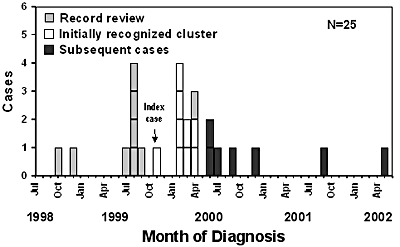Guide to the Application of Genotyping to Tuberculosis Prevention and Control
Tuberculosis Genotyping Case Studies: How TB Programs Have Used Genotyping
Homeless Shelter Outbreak Investigation: Universal Genotyping Can Help in the Early Identification of Outbreaks
In April 2000, staff members of Wake County Human Services in North Carolina became concerned about a recent increase in reports of TB in men at a Raleigh homeless shelter. An extensive investigation lasted several months and included the screening of 620 shelter residents and 26 employees. Initially, the investigation established that a) an outbreak probably was occurring, b) many of the affected persons were HIV-infected, and c) transmission probably was centered at a single homeless shelter in Raleigh (McElroy 2003).
Subsequently, the investigators conducted a careful record review and genotyped isolates from all 72 Wake County patients who had culture-confirmed TB from January 1998 through April 2002. The genotyping results showed that the outbreak-associated genotyping cluster consisted of 25 patients. As shown in the epidemic curve, if universal genotyping had been in place at the time this outbreak began, the outbreak might have been recognized as early as August 1999, rather than in April of the following year (Figure 2.2). If aggressive control measures had been instituted in August 1999, TB in many of the 18 subsequent patients, most of whom were HIV-infected, might have been prevented.

Figure 2.2. Epidemic curve of cases investigated during an outbreak at a homeless shelter in North Carolina. If universal genotyping had been available before the outbreak, it might have been recognized as in August 1999 or even before and subsequent cases might have been prevented (McElory 2003).